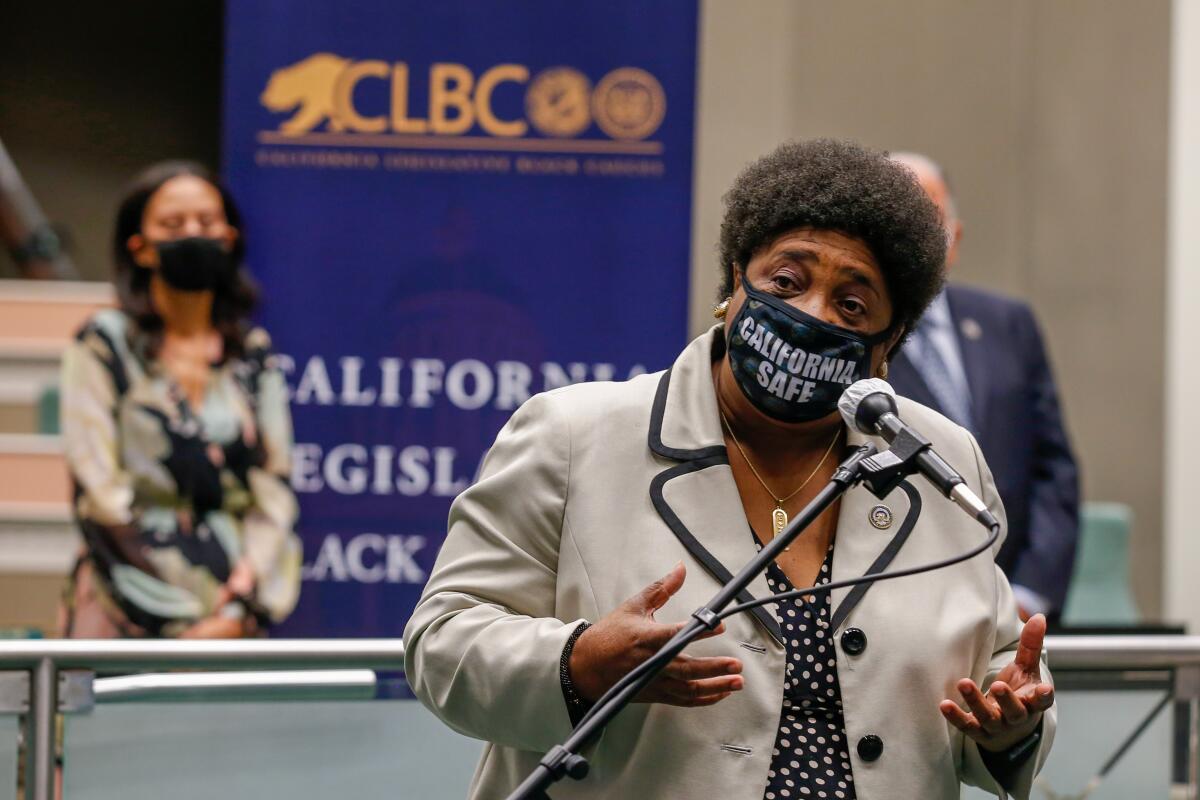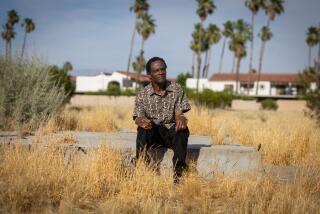California task force will consider paying reparations for slavery

- Share via
SACRAMENTO — With Gov. Gavin Newsom’s signature, California became the first state government in the country on Wednesday to adopt a law to study and develop proposals for potential reparations to descendants of enslaved people and those impacted by slavery.
Newsom said the new law and bipartisan support for its passage are proving “a paradigm that we hope will be resonant all across the United States.”
In a year of national protests against racial injustice, state lawmakers approved Assembly Bill 3121 to force the state to begin to confront its racist history and systemic disparities that persist today. Although California entered the Union as a “free state” in 1850, slavery continued there after the state Constitution outlawed it the previous year. Slavery was abolished by the 13th Amendment to the U.S. Constitution in 1865.
The new law creates a task force to recommend appropriate remedies to the state Legislature and determine who should be eligible to receive compensation, which advocates hope will become a model in a country where movements to make amends for centuries of slavery have failed to gain traction at the federal level.
“California has come to terms with many of its issues, but it has yet to come to terms with its role in slavery,” said Assemblywoman Shirley Weber (D-San Diego), the author of AB 3121. “We’re talking about really addressing the issues of justice and fairness in this country that we have to address.”
The task force, which comprises nine members to be appointed by the governor and legislative leaders, will conduct a sweeping examination of slavery in California and the United States and the lasting consequences of discrimination against freed slaves and their descendants. The group is expected to consider the ways in which slavery has benefitted private and public institutions and led to lasting disparities related to wealth, education, employment, health and incarceration.
The bill states that 4 million African people and their descendants were enslaved in the United States from 1619 to 1865, and the practice was constitutionally approved for more than 75 years.
California has a long history of allowing slavery and discrimination, dating back to before it gained statehood.
Southerners brought slaves to California in 1848 to work in the gold mines during the gold rush, according to the California Historical Society. Though California banned slavery in its constitution in 1849 ahead of joining the Union the following year, loopholes in its legal system allowed slavery and discrimination against freed slaves to continue.
California’s first governor, in his inaugural address, recommended the Legislature ban freed slaves from the state.
“Had they been born here, and had acquired rights in consequence, I should not recommend any measure to expel them,” Gov. Peter Burnett said to the Legislature in late 1849. “They are not now here, except a few in comparison with the numbers that would be here; and the object is to keep them out.”
Federal fugitive slave laws compelled citizens and governments to help return those who had escaped slavery to the South. California passed its own fugitive slave law in 1852, which stated that all enslaved people who escaped to or were brought into California before it became a state were considered fugitives and the property of the slave owner from whom they fled or who brought them there to work.
The law was interpreted to allow slaveowners to bring enslaved people to California to work and eventually return with them to the South, according to an article published in the Journal of Negro History in 1918. Slave owners also sold those they enslaved if they didn’t want to pay for their return travel, or charged them for their freedom.
The California Historical Society also notes that advertisements for the sale of enslaved people appeared in local newspapers.
“The law wasn’t really enforced in California and so people brought slaves with them to California,” said Charles P. Henry, professor emeritus of African American Studies at UC Berkeley.
Until 1863, California also had laws that barred Black people from testifying against white people in court.
Racial discrimination has persisted into more modern times, with issues such as school segregation and busing dividing cities including Los Angeles into the 1970s. Just last year, the Sausalito Marin City School District received the state’s first desegregation order in 50 years.
White homeowners for decades restricted Black people from living in their neighborhoods under agreements not to sell to Black buyers.
The California Legislature passed a law in 1963 to ban discrimination on the basis of race in the sale or rental of public housing or apartments, but voters overturned it the following year.
“It was thrown out so we have had housing segregation, which of course leads to school segregation,” Henry said. “It leads to not only the absence of living in better neighborhoods, but also having better schools and all the implications that drove from that kind of discrimination. We could go on down the list in terms of criminal justice, et cetera. This history of California has been heavily documented by scholars throughout California and in the nation.”
Movements to pay reparations have long existed, but no state has approved such a sweeping law to consider ways to make amends for slavery and its effects.
The state of Florida paid more than $2 million in reparations to survivors of the 1924 Rosewood massacre, in which white mobs destroyed the Black community and killed at least six people. The payments, approved in a 1994 law, included $150,000 to each of nine survivors and $500,000 total for their descendants, some of whom were also eligible for scholarships to cover tuition and fees.
In 1988, Congress approved $20,000 to each survivor of the Japanese American internment camps during World War II. The bill, with a total cost of $1.25 billion, paid nearly 62,000 former internees and residents of the Aleutian Islands who were relocated during the war and their community destroyed.
Through a partnership with a private donor, Virginia in 2004 created college scholarships for state residents who lost access to education when public schools in Prince Edward County and other communities closed in the 1950s and ‘60s in defiance of a landmark Supreme Court case, Brown vs. Board of Education, which ruled school segregation unconstitutional.
California law says that state reparations would not be considered a replacement for reparations at the federal level, which have failed to advance for more than a century.
The first congressional bill to provide pensions to people who had formerly been enslaved was introduced in 1890 and failed to pass. Members of Congress have introduced a resolution to establish a commission to study and develop reparation proposals — which was used as a model for Weber’s bill — in every session since 1989.
Critics of the California law contended that it’s the federal government’s responsibility to provide reparations, which Weber agrees with.
“I think it should start at the federal level, but will it?” Weber said. “The fact that it didn’t doesn’t mean I need to stand here crying for the next 40, 50 years until it starts at the federal level.”
Weber said the intent of the California law is for the task force to prioritize potential reparations for African American people who are “descendants of enslaved people or those who were impacted by slavery.”
The law does not prescribe a form of reparations or dictate how the state should determine who would qualify for compensation, leaving those questions up to the task force to study and recommend. In order for those recommendations to be acted upon, the Legislature would need to pass another bill to approve reparation payments.
Weber said she hopes the task force will consider forms of reparations beyond cash payments.
She referenced an 1865 order by the Union to give freed slaves “40 acres and a mule” — which, as scholar Henry Louis Gates Jr. explains, was later reversed — as an opportunity to build wealth, but offered more recent ideas about helping with a down payment for a home and ways to provide access to better education among other potential areas of consideration.
“When you start looking at the difference between poor whites and poor Blacks, it’s an enormous wealth gap just among those groups alone,” Weber said. “So, hopefully, they will look at what policies we put in place, and that they will have a list of policies that they believe the Legislature might want to take up.”
The new law calls on the task force to educate the public about the history of slavery in the U.S. and California and the discriminatory policies that came after.
Last year, Newsom apologized to Native Americans for a history of “violence, maltreatment and neglect,” which included slavery and genocide, and developed a Truth and Healing Council to correct the historical record about the state’s treatment of Indigenous people and discuss potential reparations.
Although there are many different forms of possible reparations, Henry said a similar agreed-upon set of facts about the treatment of Black people and an apology would be a good start.
“I think that this whole notion of truth and reconciliation needs to begin with some recognition of some responsibility and accountability here and until you have that, you can’t really talk about sort of any meaningful kinds of reparations,” he said.
More to Read
Sign up for Essential California
The most important California stories and recommendations in your inbox every morning.
You may occasionally receive promotional content from the Los Angeles Times.











